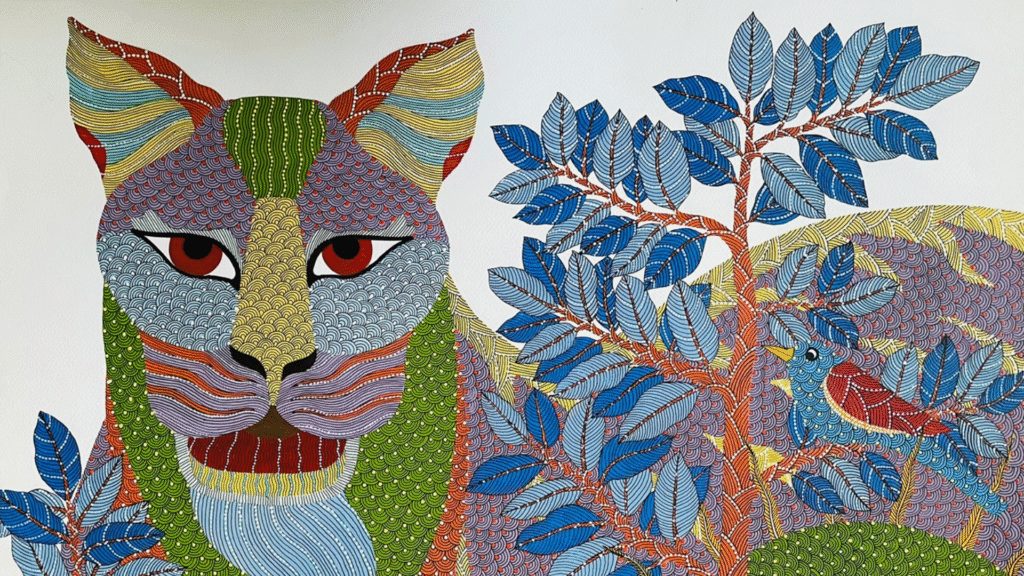In a world of digital design and AI-generated illustrations, two timeless Indian tribal art forms are making a dramatic comeback — Warli vs Gond. These are not just decorative patterns painted on walls; they are cultural identities, ancestral stories, and visual scriptures passed through generations.
With modern artists, brands, and even fashion houses turning their gaze towards these indigenous expressions, a fascinating question arises: Which one stands out more — Warli or Gond? Or better yet — can they even be compared?
Welcome to the ultimate tribal art face-off: Warli vs Gond – A Tribal Art Showdown.
The Roots of Tribal Expression
Before diving into their differences, let’s understand what makes tribal art truly special.
India is home to over 700 tribes, each with its own folklore, mythology, and art forms. These paintings are more than just visuals — they serve as:
- Social documentation
- Ritualistic expression
- A means of passing history orally and visually
Warli and Gond are two of the most prominent and recognized tribal art forms, both with UNESCO-level cultural value, yet drastically different in origin, technique, and storytelling.
What is Warli Art?
📍 Origin:
- State: Maharashtra
- Tribe: Warli tribe from the Sahyadri region
- Date: Over 2,000 years old
Warli art originated as a ritualistic wall painting in the mud huts of the Warli people. It was traditionally done by women during weddings, harvests, and religious festivals.
🖌️ Materials Used:
- Base: Cow dung–plastered mud walls
- Paint: White paste made from rice flour, water, and gum
🔺 Visual Style:
- Dominantly monochrome
- Uses geometric shapes (circle, triangle, square)
- Human figures appear like stick figures
- Symmetrical patterns
- No facial expressions, but high movement
💬 Themes:
- Farming, hunting, dancing
- Marriage rituals
- Nature worship
- Community life
What is Gond Art?
📍 Origin:
- State: Madhya Pradesh
- Tribe: Gond tribe, one of India’s largest
- Date: Rooted in the 7th century but popularized in the 1980s
Gond art originated as decorative storytelling on floors and walls, later migrating onto canvas and paper thanks to artists like Jangarh Singh Shyam, who introduced it to the urban art world.
🖌️ Materials Used:
- Base: Paper, canvas, walls
- Paint: Natural dyes, acrylics, charcoal, and mud
🎨 Visual Style:
- Bright, vibrant colors
- Intricate linework
- Patterns like dots, dashes, waves
- Filled and textured backgrounds
- Stylized animals, trees, gods, and mythology
💬 Themes:
- Nature and wildlife
- Folk stories and myths
- Tribal gods and spiritual beliefs
- Daily rural life
Warli vs Gond: Key Differences
| Feature | Warli Art | Gond Art |
|---|---|---|
| Region | Maharashtra | Madhya Pradesh |
| Color Palette | Monochrome (white on brown) | Multicolored with vivid patterns |
| Techniques | Basic geometric figures | Intricate lines, dots, and dashes |
| Medium | Mud walls (now paper/canvas) | Paper, canvas, walls |
| Origin | Ritualistic & ceremonial | Storytelling & spiritual expression |
| Main Themes | Farming, dance, rituals | Animals, trees, deities, folk tales |
| Modern Use | Sarees, logos, murals | Books, textiles, digital illustrations |
Why the “Showdown” Matters
The “Warli vs Gond” comparison isn’t about which one is better. Instead, it highlights how diverse tribal art can be, even within the same country. Each tells different stories, follows distinct visual philosophies, and expresses unique worldviews.
This tribal art face-off gives us an opportunity to:
- Reintroduce ancient traditions into modern consciousness
- Support indigenous artists
- Preserve oral and visual heritage
Warli and Gond in Contemporary Spaces
🏢 In Urban Art:
- Warli murals now adorn offices, cafes, and public spaces
- Gond-inspired art is featured in museums and galleries globally
👜 In Fashion:
- Designers like Anita Dongre and FabIndia have integrated Warli and Gond motifs into ethnic collections
📱 In Digital Media:
- Instagram artists and illustrators are reinventing tribal art with digital brushes
- NFT creators are now experimenting with digital tribal art pieces
🛒 In Home Decor:
- Wall clocks, cushion covers, ceramics, and furniture featuring these patterns are trendy on platforms like Etsy and Amazon
📣 Why You Should Care
Every time you purchase, promote, or share tribal art, you’re doing more than supporting art — you’re:
- Preserving indigenous identity
- Promoting sustainable livelihoods
- Reviving cultural diversity
- Encouraging eco-conscious art forms
🧭 Final Thoughts
Warli and Gond are not competing, they’re coexisting legacies of India’s diverse artistic heritage. In a world increasingly leaning towards global uniformity, these two tribal traditions offer a refreshing splash of authenticity, cultural pride, and ancient wisdom.
So the next time someone asks, “Warli or Gond?” — you know the answer isn’t either/or. It’s both.
🔗 You Might Also Like:
- The Art of Rangoli: Ephemeral Beauty from Indian Courtyards
- Chitrakathi of Maharashtra: Visual Storytelling for the Soul
- For More Details go this link Wikipedia
